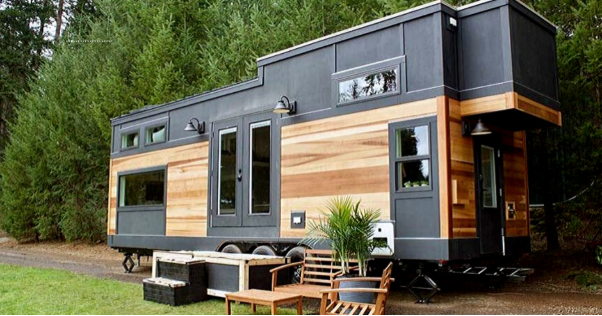Guest post from Gaetan Gabor – Gaetan Gabor is an outdoor and tiny home enthusiast who is passionate about sustainable living. He currently resides in the United States where he partakes in spreading the knowledge of alternative living styles during his free time.
As people realise the detrimental effects of our consumerist culture on the environment, interest in the tiny home movement has been growing considerably. Tiny house living is the perfect antithesis to the pervasive idea of “bigger is better.” It’s proof that the way we build our homes can make a huge difference in how we live and relate to the environment.

Tiny house living and the environment
With an average measurement of just 400 square feet or less, the sheer size of a tiny house forces one to downsize. People who live in tiny houses typically own fewer possessions and spend less overall. This leads to a lower carbon footprint and it’s one of the many reasons that motivate people to explore tiny houses as a sustainable building option.
Up until now, there wasn’t enough research to prove the correlation between downsizing to tiny houses and a reduced carbon footprint. That is, up until this research paper from a doctorate candidate from the Virginia Polytechnic Institute and State University was released.
As part of the study, the author interviewed 80 subjects who had downsized from regular homes to tiny houses to see how the switch had reduced their ecological footprint. The end goal of the study was to provide measurable evidence of the environmental benefits of downsizing to a tiny house.
The tiny house owners, who lived all across the U.S. were able to reduce their ecological footprint by up to 45%. This was based on various lifestyle factors that changed due to living in a tiny house. Below we explore just some of the ways in which the tiny home movement promotes sustainable living.

Building trends
If you look at new developments across the U.S. you’ll find that the common theme is “go big or go home.” From sky-high skyscrapers to massive mansions and estates that can take up thousands of square footage, newly-built U.S. homes are by far the largest in the world.
Concurrently, there has been a resurgence in minimalist living since the early 2000s saw a resurgence in the minimalist living trend. This is around the time when one of the most prominent tiny house construction companies was created, forever changing the way we think about space and home.
Ecological footprint
In the aforementioned study, the researcher examined the individual environmental impact of downsizing based on participant accounts. They used a metric that shows us the effects of human behaviour on nature by first looking at the amount of land required to sustain present consumption levels. This means that the researcher considered each homeowner’s spatial footprint based on global hectares. She also included contributing factors like services, goods, food, transportation, and housing. In case you’re wondering, a single global hectare is equal to 2.5 acres on average.
The data shows that the average American household has a global footprint of 8.4 hectares which translates to 20.8 acres. The respondents in the study had an average ecological footprint of about 7.01 global hectares before they downsized. This equals a total of 17.3 hectares per year. After switching to tiny house life, the participants had a significantly reduced footprint of 3.87 global hectares which is 9.5 acres.
Eco-conscious lifestyles
It seems as though downsizing also inspired the respondents to live an eco-friendly lifestyle characterised by recycling, conscious consumption and they produced less waste than before. A majority of the participants also started growing their own food, buying local produce, driving fuel-efficient cars and cycling. Even tiny house owners who downsized for reasons other than ecological motives saw a dramatic shift in their environmental footprint.
Reduced energy costs
Living in a tiny house makes it easier to go “off-grid”. In fact, most tiny houses built today come with electricity, running water and flushing toilets while being completely independent of public amenities. Instead, these homes operate on solar panels, composting toilets, and biogas digesters, which lead to significantly reduced energy and service costs.

Conclusion
There’s no denying that tiny house living can motivate people to live in ways that benefit the environment. Tiny house owners typically show a lower overall footprint than the average person, and thanks to its small square footage, a tiny house doesn’t require a lot of possessions. It’s also worth noting that it doesn’t take much to keep tiny houses cool in the summer or warm in the winter, making it easier to go “off-grid.”
These and other factors featured in the above-mentioned study provide a basis for understanding the environmental impact of the tiny house movement. Hopefully, more people can leverage it to improve building standards and drive home design trends.
